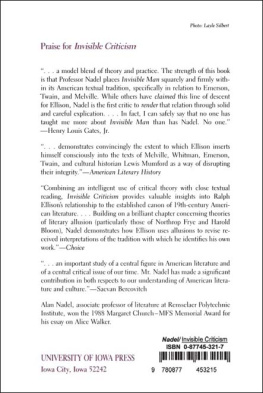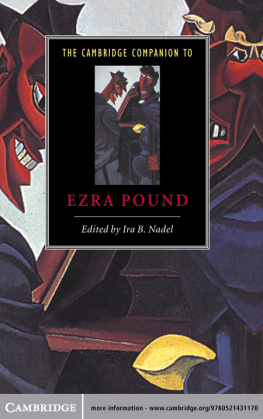AFRICAN ETHNOGRAPHIC STUDIES
OF THE 20TH CENTURY
Volume 50
NUPE RELIGION
First published in 1954 by Routledge & Kegan Paul for the International African Institute.
This edition first published in 2018
by Routledge
2 Park Square, Milton Park, Abingdon, Oxon OX14 4RN
and by Routledge
711 Third Avenue, New York, NY 10017
Routledge is an imprint of the Taylor & Francis Group, an informa business
1954 International African Institute
All rights reserved. No part of this book may be reprinted or reproduced or utilised in any form or by any electronic, mechanical, or other means, now known or hereafter invented, including photocopying and recording, or in any information storage or retrieval system, without permission in writing from the publishers.
Trademark notice: Product or corporate names may be trademarks or registered trademarks, and are used only for identification and explanation without intent to infringe.
British Library Cataloguing in Publication Data
A catalogue record for this book is available from the British Library
ISBN: 978-0-8153-8713-8 (Set)
ISBN: 978-0-429-48813-9 (Set) (ebk)
ISBN: 978-1-138-59670-2 (Volume 50) (hbk)
ISBN: 978-0-429-48744-6 (Volume 50) (ebk)
Publishers Note
The publisher has gone to great lengths to ensure the quality of this reprint but points out that some imperfections in the original copies may be apparent.
Disclaimer
The publisher has made every effort to trace copyright holders and would welcome correspondence from those they have been unable to trace.
NUPE
RELIGION
by
S. F. NADEL
Professor of Anthropology, Australian National University
ROUTLEDGE & KEGAN PAUL LTD
Broadway House, 6874 Carter Lane
London
T HIS book is intended as a sequel to my first monograph on the Nupe people, A Black Byzantium, the material presented thereon economic and political organization, and on kinship and the regulations of adolescencebeing largely presupposed in the present volume. Here and there, however, the run of the argument necessitated a somewhat fuller reference to the data contained in the earlier book, so that repetitions and some overlapping could not altogether be avoided. Much the same applies to various papers which I previously published on particular aspects of Nupe culture.
In one respect the present account might seem incomplete; for it omits the full discussion of a topic not previously treated and one well suited to the context of a book on religion, namely, myths and legends. The reason for this omission is partly a practical one, since an exhaustive treatment of Nupe legends, which would inevitably lead on to ordinary tales and folklore, would have over-burdened the present volume. But partly, the omission can be justified on the grounds that these tales and legends are of relatively little relevance for the understanding of Nupe religion, which point will be dealt with in due course.
As readers of A Black Byzantium will know, the Nupe people are today in great measure Mohammedanized, the influence of Islam steadily encroaching upon the indigenous form of worship. If, therefore, in this description of Nupe religion I were to take my lead from the actually obtaining state of affairs, I should have to assign equal weight to NupeIslam and to the traditional creed, if not indeed to give prominence to the former. In fact, I have done the reverse; more precisely, I have treated Islam in Nupe as an intrusion, as an instance (to use the familiar phrase) of culture contact, and the indigenous religion as my true or main subject-matter. I do not think that this viewpoint needs to be specially defended. The fact that the traditional observances had already disappeared from many parts of the country during my stay in 19346 and have probably receded even further since, far from detracting from our interest in the indigenous creed, only renders the task of recording and analysing it more important as well as pressing.
A purely technical point in conclusion. It is always difficult to decide, in books of this kind, just how much scope should be given to vernacular words and quotations. Clearly, in a topic like religion certain crucial terms must be given, or must at least be introduced, in the vernacular. But too generous a use of the indigenous language is both clumsy and confusing to the reader. I have therefore tried to reduce it to a minimum. Nor do I think that this entails a serious loss of accuracy; for even the most intricate vernacular terms are translatable, even though the translation itself might have to be specially explained and perhaps justified: which is precisely the procedure I propose to adopt.
CONTENTS
First published in 1954
by Routledge & Kegan Paul Ltd
Broadway House, 6874 Carter Lane
London E.C.4
Printed in Great Britain
by Butler & Tanner Ltd
Frome and London
This book has been published
with the aid of a grant from
the International African
Institute
ILLUSTRATIONS
1. PROLEGOMENA
T HE title of this book, Nupe Religion, suggests a logical unity in our subject-matter which, at the very outset, might appear problematical. Two questions, in particular, might be raised. First, are we in fact dealing with one religion of one people, that is, with beliefs and practices which both form a coherent system and occur uniformly throughout the society? And second, how far are we dealing with religion in the strict sense of the word, and with it alone, to the exclusion of magic, mere superstitions, and other, cruder forms of belief?
The answer to the first question cannot be given in the form of a simple yes or no; nor can all the issues involved properly be judged so early in the discussion. Let me, however, anticipate the relevant points. The religious beliefs and practices of the Nupe differ considerably in different parts of the country; we shall frequently meet with local cults and with forms of worship varying from region to region, even from village to village. Furthermore, the main acts of worship, their execution and promises, concern the single village community, and not that widest group, the Nupe people or tribe. Nor indeed is that widest group an unequivocal unit. The people who call themselves Nupe are internally divided in various waysby ethnic descent, by tribal segmentation and, partly, political allegiance, by the cleavage between urban and peasant population, and by the barriers of social class. The bulk of the Nupe people is held together in the kingdom of that name, and in the following description we shall mainly be concerned with the politically united tribe or nation. Even so, certain of the internal divisions remain, and these, too, entail corresponding divergences in religious belief and practice.
It might seem, therefore, that in speaking of Nupe religion we are merely employing a convenient descriptive phrase, a summary reference of the kind ethnographers find useful when they wish to state that such-and-such observances are found in a particular group or area. But the phrase is intended to mean more than this. The varieties of belief and practice found in Nupe are at least roughly akin, both in their content and in what might be called their style; though they exhibit no conspicuous uniformity or even consistency, they yet hang together in relevant respects and also reflect an identical psychological tenor. Most important of all, the people themselves think of their religion in terms of such an underlying unity; indeed, as we shall see, they tend to exaggerate it. Thus, though the local observances may differ and the congregations in acts of worship be no larger than single village communities, there is a clear understanding that the diverse and separate practices are instances of a common creed. When the people performing one kind of ceremonial comment on the different usage in another part of the country, they yet imply that the two belong together or, more precisely, belong to something wider than both. So that, over and above internal divisions, the people draw the (to them) much more important distinction between the sum total of beliefs and practices in their tribe, and the different totals of this kind in others.











